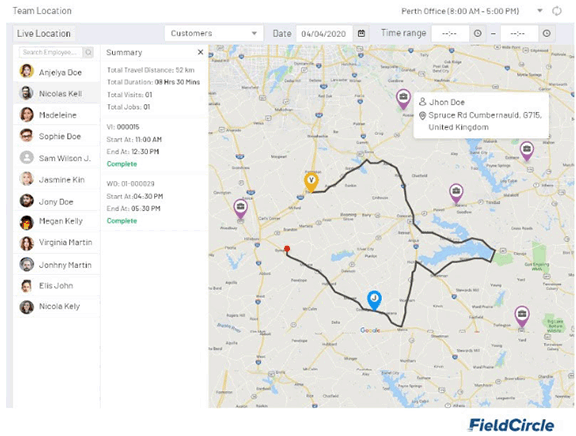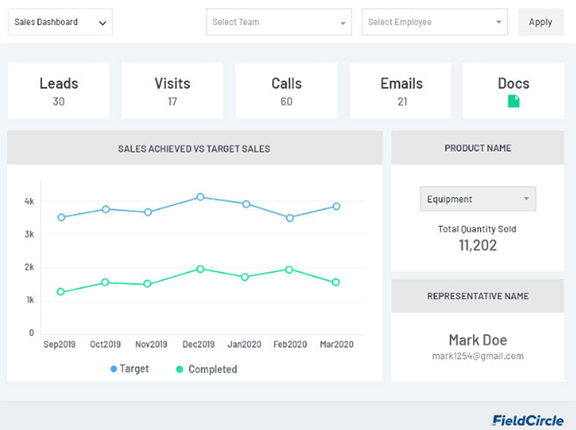6 Signs Your Field Sales Operations Process is Broken.
By
Rita Sharma - FieldCircle
When sales
slumps, pointing fingers at the sales team is a common
practice. Working with hundreds of sales professionals
has made us learn one thing—if your sales have tanked,
most times the problem may not be in your team or
resources or product but in the process.
The problem worsens when you don’t know what part of the
field sales operations process is killing the sales.
A number of elements like people (sales leaders, sales
representatives, sales consultants, or sales trainers),
operations, and market environment combine to form a
sales process, which makes it hard to find where the
process is broken—what is exactly not working.
If a certain step or component of your sales process is
not working as it should be, you get some symptoms, such
as you won’t have key information about your clients and
your business at your fingertips. It is possible that
even after successfully closing a deal you have little
clue what led you to it. In the worst case scenarios,
your potential sales leads are feeling frustrated in the
sales cycle and choosing to opt-out.
However, there are early signs too that tell loud and
clear that the field sales process is broken, which if
mended properly, could drive efficiency and revenue
growth. Those signs are:
1.
Ambiguity in Sales Productivity
How do you measure sales productivity?
Sales management expert and co-founder of Vantage Point
Performance,
Jason Jordan, has shared this quick formula to
measure sales productivity.
(Sales Effectiveness X Sales Efficiency) = Sales
Productivity, where;
Sales effectiveness is defined by the ability of the
sales person to perform tasks correctly and sales
efficiency refers to ability of sales person to perform
the tasks quickly within a given time frame.
In order to apply this formula, you need to have exact
figures either individually or of the entire team. For
example: You are a field sales manager and your team of
5 field sales representatives spread out on different
territories.
Here is what your revenue report would look like for any
given quarter.

Do you have such data at your fingertips?
Having such data is essential to measure the
productivity of each member of your team. As you can see
that both Tim and Joe have delivered the same revenue
output, but the revenue they have generated out of the
number of leads is not the same. This difference in
figures could have many possible reasons, which you
would not know until you have complete visibility into
your sales process.
If you have such visibility, you can analyze individual
and team performance and take relevant measures to
increase the field sales productivity. But there is a
catch! Do you have the data in real-time?
Taking
corrective measures after the event cannot compensate
for the previous losses. If you can view the sales
activity of your remote sales force in real time and
evaluate the time spent in business and non-business
activities, you would be able to take instant
measures to improve productivity.
Story
continues below ↓
2. Territory and Route Planning
Territory mapping is your game plan. It is a tedious
process and requires a great deal of strategy and
leg-work. If you properly categorize the territory and
assign the right size to the right territory
representative of the outside sales team, half the match
is already won.
For any sales rep, it is not an unlikely experience to
find another member of the team on their back at the
client’s location. In some cases, low potential
territories are assigned to highly-trained sales reps or
vice versa. These are some clear signs of a broken field
sales process.
By using advanced territory mapping and categorization
tools powered with route optimization systems, sales
leaders can ensure that the right sales rep is at the
right place at the right team.

With the help of such tools, you get instant visibility
into territories assigned to individual sales reps. You
can monitor and track the movement of the remote sales
team in real-time, determine the best and most
cost-effective routes, and increase response time to
last minute changes in schedule.
3. Customer-sales Team Connect
According to IMRG Stats, selling to an existing customer
has a higher success rate, up to 60-70%, as compared to
selling to a new customer, which is 5-20%.
The problem with selling to existing customers is that
they can see you are pitching through the lines, “we
also have…” or “you might be interested in our new…”
No one likes to be sold; everyone likes to buy
To really see success with such pitching, you need to
master the art of upselling and cross selling. Rather
than directly pitching them the product, focus on
“customer delight”, which you can achieve by
providing value added solutions for an existing set of
products or services.
You cannot do this on just one fine day. Convincing a
client that you care and your product has value is a
gradual process and requires persistence, patience, and
a lot of planning.
And to let that happen, you need to build and maintain
the relation with them by:
-Keeping customers engaged: Get into
engagement marketing. With the rise of the Internet and
social media, understanding user behaviour has become
easier. You can create engaging content and break into
their social circles in a way that does not make
advertising look like interruption rather entertainment.
-Establish personal connection: Wish your
customers on their birthdays. Send personalized messages
during festivals. Ask them about feedback of previous
purchases. Having such communication with customers has
two benefits; one that you make your presence felt and
the other is you let them know that you care—that they
are not on their own after the payment has been made.
-Reward, discount, and offers: Reward you
loyal customers, cherish your relationship with them by
giving discounts, and make interesting offers to attract
their attention. Inform them how they can enhance their
product (upselling) and create a combination of products
or services (cross selling) to get better results.
If such elements are missing into your sales strategy
and operations, you would not be able to utilize the
tremendous upselling and cross selling opportunities.
In order to bring these elements into your field sales
process, you need a system that keep all your customer
information in one place and allow you to sort and
filter customers by territory, purchases, and
transaction details, so that you can identify the
preferences of each customer, categorize them, and
create independent
upselling and cross selling strategies for each
category
4. Margin and Payment Cycle
As an outside sales manager, how closely are you
involved in the pricing and payment cycle? It is not an
uncommon practice among sales persons to give an
overwhelming discount to win a customer. Assuming that
you have 5 reps in your team, each of them has given
heavy discounts to at least two customers; it would
badly affect your margin.
Instead of slashing prices that could hurt your
profitability, it is essential that you stand by premium
pricing and yet win the customer. The problem is many
field sales representatives think that the buying
decision of customers is largely based on cost, which is
correct to some extent but does not hold true
throughout.
In fact, when your rep lowers the prices, customers may
think that the product is not worth the original price.
The best way to address the situation is that you set
a standard price for every product and allow your reps
to provide value added solutions, as discounts.
Similarly, you can streamline your payment processes to
ensure that invoice is generated quickly so that payment
processes can be initiated as fast as possible. A
powerful and intuitive payment processing dashboard that
provides real time reporting of every transaction,
manages payment and refunds, and configures scheduled
and recurring payments.
The dashboard can help you analyze the payment cycle
that may vary customer to customer and look into the
commitments made by the sales reps to each customer.
5. Culture
Poor attitude (as opposed to lack of skill) of your
field sales representatives can have a devastating
effect on your business. In a crowded marketplace, if
your customers find your sales rep laid back, less
interested or unprofessional in any way, they have many
options to turn to. There could be many reasons for poor
attitude, such as:
-Lack of motivated sales environment and sales
leadership
-Politics or bad behaviour of team member
-Poor reward or reimbursement process
To create a healthy workplace environment and positive
attitude among sales persons, you have to model a
behaviour that you want your employees to adopt. But the
bigger problem is how would you know that your
organization has workplace issues?
Possibly these four signs would tell you.
1- Your funnel has a great number of opportunities but a
very poor conversion rate.
2-
Members of sales and marketing teams point fingers at
each other for poor lead and conversion.
3- Your sales reps are unable to define key KPIs and you
lack the method to measure or track existing KPIs for
each rep.
4- And,
something as simple as, not having a process to collect
feedback from your prospects and customers.
You should have a robust feedback system in place for
employees as well as clients. In case of clients, a
feedback link could be shared with them where they can
reveal their experience after interacting with your
sales reps.
On the basis of the feedback you can determine the
behavior of your remote sales force with each client and
take necessary measures to resolve behavioral issues and
improve customer experience. Internally, you can hold
coaching sessions to establish communication standards,
define KPIs, and create a transparent process between
sales and marketing teams.
6. Sales Metrics
According to the State of Sales report by Salesforce,
57% of sales reps are not meeting their quota, and while
almost all sales leaders analyse some really interesting
metrics, most fail to dive deeper into the data.
Although not being able to achieve the quota is a
consequence, questions that may help in identifying why
that happens can be:
- How many hours did the field rep spend in commute and
the total distance traveled?
-
Average how many fresh prospect meetings and existing
customer meetings the rep has conducted?
-
Historically, what’s the opportunity to win data for
each rep and what are the reasons for lower numbers for
some of them?
Most
field sales operations, even the modern ones, tend
to miss a lot of similar questions and metrics resulting
in profit and opportunity leakages.
And most of the time, the solution is to have the
complete visibility of information and activity instead
of relying on instincts. If you are planning to invest
in tools to get visibility into your sales process, make
sure to get one which enable you to interpret the data
which is relevant to you.

Use integrated tools that let you deep dive into your
sales process and measure the revenue output on a number
of factors such as new customers, existing customers,
upselling and cross-selling opportunities, time spent on
follow-ups, face-to-face meetings by each rep on each
client, and so on. Once you get these facts, you can
determine what is killing your sales and take corrective
actions.
Conclusion
While the operational processes remain the same, sales
processes have incorporated a range of new methods, and
it’s important that sales leaders, with the right tools,
are able to utilize the visibility of information to
mend broken
field sales processes. It will not only drive higher
profitability and revenue but also facilitate improved
customer experience.
###
Learn how
FieldCircle can help you manage your field workforce
more effectively, drive revenue growth by 10-18%, and
improve rep productivity by 15-22%.
|
